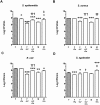Antimicrobial protein and Peptide concentrations and activity in human breast milk consumed by preterm infants at risk of late-onset neonatal sepsis
- PMID: 25643281
- PMCID: PMC4314069
- DOI: 10.1371/journal.pone.0117038
Antimicrobial protein and Peptide concentrations and activity in human breast milk consumed by preterm infants at risk of late-onset neonatal sepsis
Abstract
Objective: We investigated the levels and antimicrobial activity of antimicrobial proteins and peptides (AMPs) in breast milk consumed by preterm infants, and whether deficiencies of these factors were associated with late-onset neonatal sepsis (LOS), a bacterial infection that frequently occurs in preterm infants in the neonatal period.
Study design: Breast milk from mothers of preterm infants (≤ 32 weeks gestation) was collected on days 7 (n = 88) and 21 (n = 77) postpartum. Concentrations of lactoferrin, LL-37, beta-defensins 1 and 2, and alpha-defensin 5 were measured by enzyme-linked immunosorbent assay. The antimicrobial activity of breast milk samples against Staphylococcus epidermidis, Staphylococcus aureus, Escherichia coli, and Streptococcus agalactiae was compared to the activity of infant formula, alone or supplemented with physiological levels of AMPs. Samples of breast milk fed to infants with and without subsequent LOS were compared for levels of AMPs and inhibition of bacterial growth.
Results: Levels of most AMPs and antibacterial activity in preterm breast milk were higher at day 7 than at day 21. Lactoferrin was the only AMP that limited pathogen growth >50% when added to formula at a concentration equivalent to that present in breast milk. Levels of AMPs were similar in the breast milk fed to infants with and without LOS, however, infants who developed LOS consumed significantly less breast milk and lower doses of milk AMPs than those who were free from LOS.
Conclusions: The concentrations of lactoferrin and defensins in preterm breast milk have antimicrobial activity against common neonatal pathogens.
Conflict of interest statement
Figures






Similar articles
-
Levels of innate immune factors in preterm and term mothers' breast milk during the 1st month postpartum.Br J Nutr. 2016 Apr 14;115(7):1178-93. doi: 10.1017/S0007114516000234. Epub 2016 Feb 19. Br J Nutr. 2016. PMID: 26891901
-
Is Lactoferrin More Effective in Reducing Late-Onset Sepsis in Preterm Neonates Fed Formula Than in Those Receiving Mother's Own Milk? Secondary Analyses of Two Multicenter Randomized Controlled Trials.Am J Perinatol. 2019 Jul;36(S 02):S120-S125. doi: 10.1055/s-0039-1691807. Epub 2019 Jun 25. Am J Perinatol. 2019. PMID: 31238372
-
Lactoferrin Expression Is Not Associated with Late-Onset Sepsis in Very Preterm Infants.Neonatology. 2020;117(5):606-611. doi: 10.1159/000509404. Epub 2020 Aug 28. Neonatology. 2020. PMID: 32862184
-
Comparison of different protein concentrations of human milk fortifier for promoting growth and neurological development in preterm infants.Cochrane Database Syst Rev. 2020 Nov 20;11(11):CD007090. doi: 10.1002/14651858.CD007090.pub2. Cochrane Database Syst Rev. 2020. PMID: 33215474 Free PMC article.
-
Human milk-derived fortifier versus bovine milk-derived fortifier for prevention of mortality and morbidity in preterm neonates.Cochrane Database Syst Rev. 2019 Nov 7;2019(11):CD013145. doi: 10.1002/14651858.CD013145.pub2. Cochrane Database Syst Rev. 2019. PMID: 31697857 Free PMC article.
Cited by
-
How much does a liter of donor human milk cost? Cost analysis of operating a human milk bank in Italy.Int Breastfeed J. 2022 Dec 20;17(1):90. doi: 10.1186/s13006-022-00530-4. Int Breastfeed J. 2022. PMID: 36539788 Free PMC article.
-
Immunomodulatory Properties of Human Breast Milk: MicroRNA Contents and Potential Epigenetic Effects.Biomedicines. 2022 May 24;10(6):1219. doi: 10.3390/biomedicines10061219. Biomedicines. 2022. PMID: 35740242 Free PMC article. Review.
-
Human Breast Milk Contamination with Aflatoxins, Impact on Children's Health, and Possible Control Means: A Review.Int J Environ Res Public Health. 2022 Dec 14;19(24):16792. doi: 10.3390/ijerph192416792. Int J Environ Res Public Health. 2022. PMID: 36554670 Free PMC article. Review.
-
Clinical implications of preterm infant gut microbiome development.Nat Microbiol. 2022 Jan;7(1):22-33. doi: 10.1038/s41564-021-01025-4. Epub 2021 Dec 23. Nat Microbiol. 2022. PMID: 34949830
-
Variability of Serum Proteins in Chinese and Dutch Human Milk during Lactation.Nutrients. 2019 Feb 27;11(3):499. doi: 10.3390/nu11030499. Nutrients. 2019. PMID: 30818777 Free PMC article.
References
Publication types
MeSH terms
Substances
Grants and funding
LinkOut - more resources
Full Text Sources
Other Literature Sources
Medical

